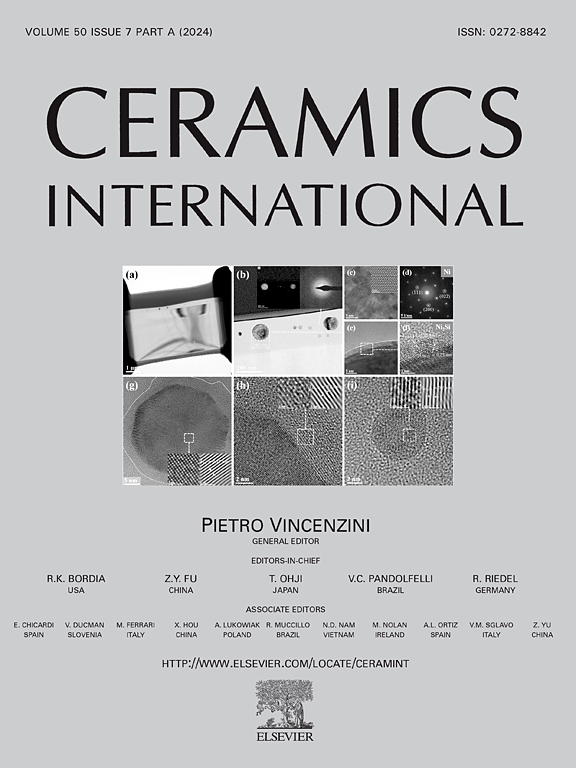Effect of halloysite nanotubes on poloxamer 407-containing calcium phosphate cement for bone repair applications
IF 5.6
2区 材料科学
Q1 MATERIALS SCIENCE, CERAMICS
引用次数: 0
Abstract
Owing to the associated biocompatibility, bioactivity, and osteoconductivity, calcium phosphate cements (CPCs) are widely used for bone repair and augmentation. Despite these advantages, commercially available CPCs often exhibit insufficient strength and injectability for clinical applications. In this study, we aimed to address these limitations by incorporating halloysite nanotubes (HNTs) and poloxamer 407 into CPCs. HNTs, known for their high mechanical strength, modulus, specific surface area, and aspect ratio, were added to improve the mechanical properties of the CPCs. To enhance injectability and minimize leakage from the bone defects, poloxamer 407 was incorporated into the CPCs. The incorporation of HNTs significantly enhanced the compressive strength (CS) of the cement to cement without HNTs, achieving a maximum improvement of 6.8 MPa, which corresponds to a 16.9 % increase. The injectability decreased over time for all pastes during the poloxamer 407 sol-gel transition. HNT incorporation did not negatively affect cell viability or induce cytotoxicity, and enhanced cell adhesion and spreading were observed on the CPC surfaces, as demonstrated by in vitro studies using MC3T3-E1 cells. Alkaline phosphatase activity assays indicated improved osteogenic differentiation with HNTs. These results suggest that incorporating up to 3 wt% HNTs into CPCs optimizes their mechanical properties and biological performance, making them suitable for load-bearing applications in bone tissue engineering. Nevertheless, future in vivo studies are necessary to validate these findings and establish the clinical utility of HNT-reinforced CPCs incorporating poloxamer 407.
高岭土纳米管对含泊洛沙姆407磷酸钙骨水泥骨修复的影响
由于相关的生物相容性、生物活性和骨导电性,磷酸钙水泥(CPCs)被广泛用于骨修复和增强。尽管有这些优点,市售cpc在临床应用中往往表现出强度和注射性不足。在本研究中,我们旨在通过将高岭土纳米管(HNTs)和波洛沙姆407掺入CPCs来解决这些局限性。加入HNTs以其高机械强度、模量、比表面积和长径比而闻名,以改善CPCs的机械性能。为了提高可注射性并减少骨缺损的渗漏,poloxam407加入到CPCs中。与未掺入HNTs的水泥相比,掺入HNTs显著提高了水泥的抗压强度(CS),最大提高了6.8 MPa,相当于提高了16.9%。在poloxomer 407溶胶-凝胶过渡期间,所有膏体的注射性随着时间的推移而下降。使用MC3T3-E1细胞进行的体外研究表明,HNT掺入不会对细胞活力产生负面影响或诱导细胞毒性,并且可以增强细胞在CPC表面的粘附和扩散。碱性磷酸酶活性测定显示HNTs改善了成骨分化。这些结果表明,在cpc中加入高达3 wt%的HNTs可以优化其机械性能和生物性能,使其适合骨组织工程中的承重应用。然而,未来的体内研究是必要的,以验证这些发现,并建立含有波洛沙姆407的hnt增强cpc的临床应用。
本文章由计算机程序翻译,如有差异,请以英文原文为准。
求助全文
约1分钟内获得全文
求助全文
来源期刊

Ceramics International
工程技术-材料科学:硅酸盐
CiteScore
9.40
自引率
15.40%
发文量
4558
审稿时长
25 days
期刊介绍:
Ceramics International covers the science of advanced ceramic materials. The journal encourages contributions that demonstrate how an understanding of the basic chemical and physical phenomena may direct materials design and stimulate ideas for new or improved processing techniques, in order to obtain materials with desired structural features and properties.
Ceramics International covers oxide and non-oxide ceramics, functional glasses, glass ceramics, amorphous inorganic non-metallic materials (and their combinations with metal and organic materials), in the form of particulates, dense or porous bodies, thin/thick films and laminated, graded and composite structures. Process related topics such as ceramic-ceramic joints or joining ceramics with dissimilar materials, as well as surface finishing and conditioning are also covered. Besides traditional processing techniques, manufacturing routes of interest include innovative procedures benefiting from externally applied stresses, electromagnetic fields and energetic beams, as well as top-down and self-assembly nanotechnology approaches. In addition, the journal welcomes submissions on bio-inspired and bio-enabled materials designs, experimentally validated multi scale modelling and simulation for materials design, and the use of the most advanced chemical and physical characterization techniques of structure, properties and behaviour.
Technologically relevant low-dimensional systems are a particular focus of Ceramics International. These include 0, 1 and 2-D nanomaterials (also covering CNTs, graphene and related materials, and diamond-like carbons), their nanocomposites, as well as nano-hybrids and hierarchical multifunctional nanostructures that might integrate molecular, biological and electronic components.
 求助内容:
求助内容: 应助结果提醒方式:
应助结果提醒方式:


